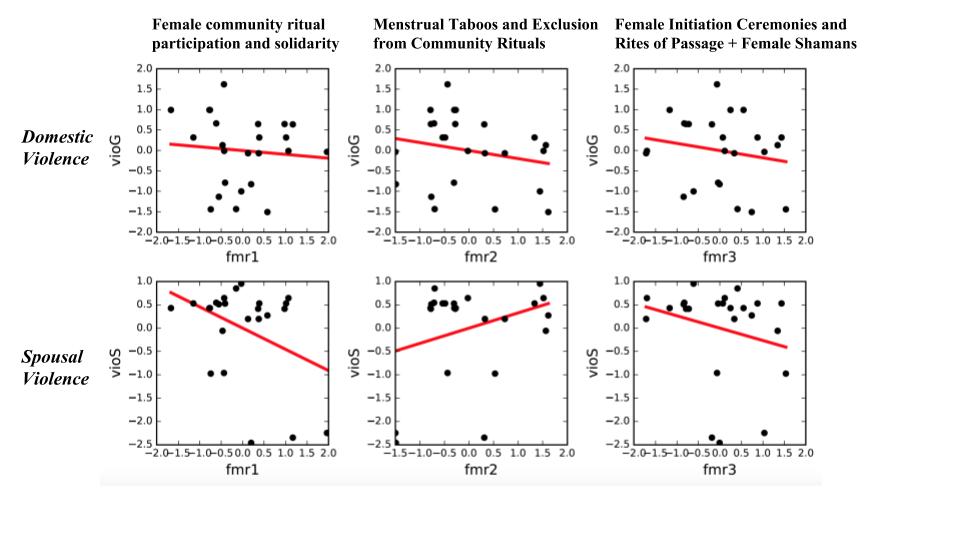Are women more religious than men? There is significant pre-existing research that indicates people of different genders differ in both their levels of religiosity and the types of religious experiences they have. But much of that research looks at gender through an outdated and dualistic lens that projects ethnocentric ideas of sex and gender across a wide variety of cultural and historical settings. In order to develop new methods for analyzing the interplay between biological, cultural, and individual factors that underlie sex and gender, it’s apparent that we need to update the conversation and explore new theories of sex differences and religion.
Approach
The Sex Differences team drew upon previous research at the intersection of sex, gender, and culture to formulate clear and testable hypotheses. They then gathered together existing (online and printed) datasets of cultural variables drawn from 216 diverse cultures worldwide. From this data they generated a new and cohesive database of variables relating to factors such as religious ritual behavior, patterns of spousal dispersion, and gender roles and hierarchies.
Through statistical analyses, using techniques such as Principal Components Analysis, the Sex Differences team found that their variables could be consolidated under three specific domains: Regulation of Female Bodies, Female Ritual Power, Female Ritual Solidarity. This discovery has helped to shape and reorganize older databases into a more streamlined and accessible format, which the SDP team will eventually make available to the public.
The resulting cross-cultural database helps formulate questions that can guide future qualitative and quantitative research on a variety of topics within this nexus. This database also underlines the pressing need to venture beyond simplistic models of both gender and religion.
Impact
The Sex Differences Project is contributing to the growing body of research on sex differences and religion. First, with the support of Boston University’s Women’s, Gender and Sexualities Studies Program, School of Theology and Danielsen Institute, the team organized an interdisciplinary conference called “Sex on the Margins: Navigating Religious, Social, and Natural Scientific Models of Sex Differences” that led to a special issue of the journal Theology and Sexuality, both of which have stimulated further dialogue surrounding sex, gender, sexuality, and religion.
Second, research on the SDP Database found that societies with certain types of female-specific rituals (higher levels of female ritual solidarity and ritual power) have a lower occurrence of domestic violence against women, which was also significantly related to differences in post-marital residence patterns. This demonstrates the specific power of cultural rituals in shaping social dynamics and patterns of violence, even in the home, and suggests a key role of religious ritual in forging protective alliances between women.
 Third, the team discovered a more refined way to identify gender differences in spiritual and religious and spiritual experiences. The key to this is an extension of Ron Pekala’s Phenomenology of Consciousness Inventory to cover religious and spiritual experiences. Using those results, a computer was able to guess gender, age, political leaning, and other demographic characteristics of those undergoing these experiences better than expert raters could predict on the basis of deidentified narratives of the same experiences. This validates the team’s working hypothesis that gender (and other) differences correspond to material differences in the subjective qualities of religious and spiritual experiences.
Third, the team discovered a more refined way to identify gender differences in spiritual and religious and spiritual experiences. The key to this is an extension of Ron Pekala’s Phenomenology of Consciousness Inventory to cover religious and spiritual experiences. Using those results, a computer was able to guess gender, age, political leaning, and other demographic characteristics of those undergoing these experiences better than expert raters could predict on the basis of deidentified narratives of the same experiences. This validates the team’s working hypothesis that gender (and other) differences correspond to material differences in the subjective qualities of religious and spiritual experiences.
Overall, these findings illustrate the importance of combining the insights of gender and feminist theory with evolutionary models of religiosity and ritual behavior in order to arrive at a more complex understanding of the entanglement between biology, brains, and culture – the mind-culture nexus.
Prevailing models of sex and gender tend to be biomedical, religious, and/or social. This project not only adds a new frame of reference but also pushes for a more realistic and interdisciplinary model based on empirical research on gender and sex differences. SDP draws attention to the way models of gender and sex affect human experience both in the present and across human history.
Publications
Kate J. Stockly, Stephanie Arel, Megan K. DeFranza, Luke Matthews, Damian Ruck, and Wesley J. Wildman, “Women-centered rituals and levels of domestic violence: A cross-cultural examination of ritual as a signaling and solidarity-building strategy.” Journal for the Study of Religion, Nature and Culture 14/1 (2020): 95-123.
DeFranza, Megan K., Stephanie N. Arel, and Kate Stockly. (2018). “Sex on the margins: Centering intersex, transgender, and sexually fluid voices in religious and scientific discourse.” Theology and Sexuality, DOI: 10.1080/13558358.2018.1463636.
*DeFranza, Arel and Stockly also compiled and edited this entire edition of Theology and Sexuality Volume 24 Issue 2 (2018). See here for the complete version.
Wood, Connor P., and Kate J. Stockly. (2018). “Complexity and possession: Gender and social structure in the variability of shamanic traits.” Behavioral and Brain Sciences, 41: e91.

